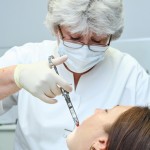
Articaine is a member of the amide family that also includes lidocaine, mepivacaine, bupivicaine and prilocaine. It was first synthetised in 1969 and made available for clinical use in 1976 with the FDA approving 4% articaine with 1:200,00 adrenaline in 2006. Lidocaine has been the most common dental local anaesthetic and is often used as the gold standard although the use of articaine is growing in popularity.
The aim of this review was to assess the safety and efficacy of articaine for routine dental treatment compared to lidocaine.
Methods
Searches were conducted in the Medline Ovid, Medline PubMed, Scopus, Emcare, Proquest and the Cochrane Central register of Controlled Trials databases. Randomised controlled trials (RCTs) published in English involving 4% articaine and 2% lidocaine in routine dental treatment were considered. Outcome measures included anaesthetic success, anaesthetic onset and duration and post intervention LA-related adverse events. anaesthetic success, anaesthetic onset and duration and post intervention LA-related adverse events. Data was extracted and risk of bias assessed using the Cochrane Risk of Bias 2. Odds ratios (OR). And 95% confidence intervals were the main summary measures.
Results
- 12 RCTs involving a total of 919 patients were included.
- All 12 studies contributed to the meta-analyses with articaine showing statistically greater success than lidocaine in all analyses (see table).
| No. of studies | Odds Ratio (95% CI) | |
| All Local anaesthetic | 12 | 2.17 (1.50 to 3.15) |
| Mandibular blocks | 4 | 1.50 (1.14 to 1.98) |
| Mandibular infiltrations | 5 | 3.01 (1.31 to 6.94) |
| Maxillary infiltrations | 3 | 2.61 (1.49 to 4.57) |
| All infiltrations (Mand & Max) | 8 | 2.78 (1.61 to 4.79) |
| Mandibular arch injections | 9 | 2.09 (1.33 to 3.29) |
| Symptomatic teeth | 7 | 1.89 (1.09 to 3.27) |
| Asymptomatic teeth | 5 | 2.51 (1.47 to 4.34) |
| Parallel studies | 8 | 1.95 (1.17 to 3.25) |
| Cross-over studies | 4 | 2.45 (1.35 to 4.47) |
- Studies were conducted in Finland, India, Iran, Thailand and the U.S.A.
- All 12 studies were considered to be at unclear risk of bias.
- 8 studies included data on adverse effects which were only minor and temporary.
Conclusions
The authors concluded: –
Articaine is a safe and efficacious local anaesthetic for all routine dental procedures in patients of all ages, and more likely to achieve successful anaesthesia than lidocaine in routine dental treatment. Neither anaesthetic has a higher association with anaesthetic-related adverse effects.
Comments
The authors registered the review on PROSPERO and have undertaken a broad database search although restricting inclusion to studies published in the English language may have excluded some relevant studies as acknowledged by the authors. While a typical systematic review methodology there is no indication of duplicate study selection, data abstraction or risk of bias assessment. Overall, the findings suggest that articaine is safe and effective for use in routine dental practice with similar findings being demonstrated in other reviews (Dental Elf -Articaine Blogs).
Links
Primary Paper
Martin E, Nimmo A, Lee A, Jennings E. Articaine in dentistry: an overview of the evidence and meta-analysis of the latest randomised controlled trials on articaine safety and efficacy compared to lidocaine for routine dental treatment. BDJ Open. 2021 Jul 17;7(1):27. doi: 10.1038/s41405-021-00082-5. Erratum in: BDJ Open. 2021 Aug 11;7(1):29. PMID: 34274944; PMCID: PMC8286260.
Other references

Articaine is usually used in a strength of 4% as opposed to Lignocaine of 2%. What this means is if you are doing a lot of procedures in the mouth requiring local anaesthetic, then toxic dose are more readily achieved with Articiane than Lignocaien due to it”s higher concentration.
It is good to be aware of the potential toxicity of local anaesthetic solutions. Articaine does have a serum half-life of 20-30 minutes and anumal studies shoew that it has low toxicity compared with other amide local anaesthetics. Articaines toxicity is considered to be comparable with lidocaine and safe for routine clinical dentistry.
The Dental Elf